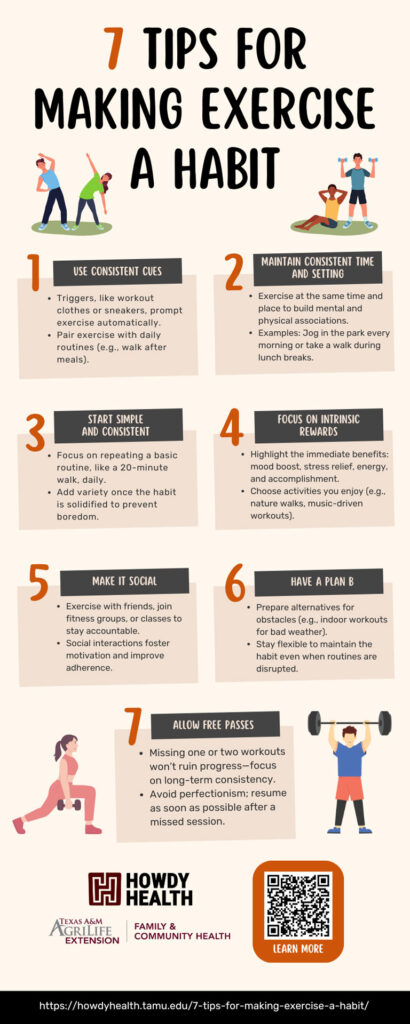We’ve all been there – starting an exercise routine with loads of enthusiasm, only to find ourselves skipping workouts a few weeks later. It’s tough to stay consistent, but what if exercise became as automatic as brushing your teeth? Imagine not having to summon willpower every time you want to work out! The good news is, forming a lasting exercise habit isn’t about motivation alone – it’s about building a routine that sticks.
Habits are automatic behaviors or actions, often triggered by cues, that don’t require much conscious thought.1 Developing a habit takes time. According to research, it takes an average of 66 days2 (or roughly 10 weeks)1 for a new behavior to become automatic.
With the right strategies and a little patience, you can make exercise a regular, enjoyable part of your life. This article explores seven research-backed tips for making exercise a lasting habit, along with practical examples to help you incorporate these strategies into your life.
1. Use consistent cues
Cues, also called signals or triggers, play a vital role in habit formation and can help reduce the mental effort needed to start a workout. A cue is something that reminds you or prompts you to start a behavior automatically.3
Example
If you want to exercise in the morning, lay out your workout clothes next to your bed. For a lunch-hour routine, place your sneakers by your office door when you arrive. For an evening option, put your workout bag in your car seat when you go into work. These items can serve as a visual cue. Seeing your clothes, shoes, or workout bag will trigger the routine of getting dressed and working out. Similarly, pairing exercise with an existing daily activity, like walking the dog after breakfast or dinner, creates a natural cue.
2. Create consistent contexts: time and setting
Establishing a consistent context by maintaining the same time and setting for exercise each day can strongly reinforce habit formation. By exercising within a familiar context – at a regular time and in a specific place – you create both mental and physical associations with the activity, gradually reducing resistance. Research shows that consistent contexts help behaviors become automatic, turning physical activity into a habit over time.1.2,4,5 It doesn’t matter what time you choose or where you choose to exercise; it’s just important to keep the time and place consistent so that you can establish a habit where your participation in physical activity becomes automatic.
Example
If you always go for a jog at 7 a.m. in the same park, your brain will start to associate that time and place with the activity. Over time, your body and mind will anticipate exercise when you encounter those contexts, making it easier to follow through. If you want to add activity to your workday, your consistent lunch hour can serve as a consistent contextual cue that you will go for a 15-minute walk around the building after you eat lunch each day. Pairing exercise with an existing daily activity (lunch) at a common time and in a usual place creates a natural cue.
3. Start with a routine without variation
In the beginning, consistency is more important than variety. Doing the same workout, at the same time, in the same setting helps create automaticity – the process of doing something without much thought. Habit formation is more successful when the behavior is consistent, simple, and easy to repeat daily. By removing variation at first, the behavior becomes ingrained more quickly. Once the habit is solidified, variation can be introduced to maintain interest and prevent boredom.1,2
Example
If you’re starting a workout routine, begin with a simple 20-minute walk every day at the same time. Focus on sticking to this routine without worrying about the type of workout or intensity. As the habit forms, you can vary the exercises, adding strength training or increasing cardio intensity.
4. Give it personal value by focusing on intrinsic rewards
One of the most powerful ways to create a lasting exercise habit is to focus on intrinsic motivation – the personal satisfaction and enjoyment that come from the activity itself. When exercise holds personal value and provides internal rewards, such as the joy of movement, stress relief, improved mood, mental clarity, or a sense of accomplishment, it becomes more than just a task on your to-do list. Studies show that intrinsic motivation is one of the strongest predictors of long-term exercise adherence. When people exercise for personal satisfaction, they’re more likely to make it a regular habit. Additionally, behaviors that are pleasurable or intrinsically motivating may become habitual after fewer repetitions than those that are not, since pleasure and intrinsic motivation act as rewards, which can accelerate habit formation. Instead of relying on external goals, like weight loss or appearance, which can feel distant and unfulfilling, intrinsic rewards make the activity immediately rewarding and easier to stick with in the long run.4,6,7,8
Example
Think about how good you feel after a workout. Maybe you experience a mood boost, reduced stress, more energy throughout the day, or a sense of accomplishment. Focus on these immediate benefits rather than long-term outcomes like a number on the scale. If you enjoy nature, go for a walk in the park. If you love music, create a playlist that gets you excited for a workout. The more you enjoy the process, the more likely you are to continue exercising regularly.
5. Make it social
Social support is a powerful tool for habit formation. Exercising with others creates a sense of accountability, encouragement, and shared experience, all of which increase the likelihood of maintaining a routine. Research suggests social support can also encourage optimism and self-esteem, reducing stress and depressive symptoms, which could affect adherence to exercise.9 Relatedness – feeling like you belong or relate to a group – can also improve motivation and increase adherence to exercise.4,9
Example
Find a workout partner, join a fitness class, a walking or running club, or join Walk Across Texas. Knowing that someone is expecting you to show up can make you less likely to skip a workout. Additionally, having someone to share your progress with can make the experience more enjoyable and rewarding.
6. Have a plan B for obstacles
Life is unpredictable, and barriers to exercising will inevitably arise. Having a “Plan B” ensures you don’t give up entirely when something gets in the way. Identify common obstacles in advance and create alternative solutions. Planning for obstacles and creating alternative strategies is an effective way to maintain exercise consistency.10 It reduces the likelihood of abandoning the habit after a disruption.
Example
If you can’t make it to the gym because of a late work meeting, have a 20-minute home workout ready. If the weather prevents your usual outdoor walk, do an indoor bodyweight routine instead or move your walk to the local mall. If you can’t fit your usual 30-minute workout into an especially busy day, just do 15 minutes. The key is to stay flexible and keep the habit going, even in a modified form.
7. Give yourself a free pass
Perfection is not necessary for habit formation. Life is unpredictable and missing a day or two of exercise won’t ruin your progress. In fact, research suggests that although repetition of a behavior is required to form a habit, some missed opportunities won’t derail the process. Missing one or two days during the habit formation process doesn’t significantly impact long-term success.2 The key is to avoid letting one missed day turn into a complete derailment. It’s easy to have the “all-or-nothing” attitude, where missing an exercise session or two causes us to give up on exercise all together. It can be especially hard to get back to it if we break a streak of consistent exercise. It’s important to be gracious, gentle, and flexible with yourself. Give yourself a free pass – like a “get-out-of-jail-free” card in Monopoly. In fact, if it helps, make several free pass cards and use them when you need them.
Example
If you skip a workout because you’re sick or have an unusually busy day, don’t be too hard on yourself. Resume your routine as soon as possible. Acknowledge that life happens and focus on long-term consistency rather than perfection.
Conclusion
Forming an exercise habit is a process that takes time, patience, and the right strategies. While it may seem daunting to make exercise a regular part of your life, using cues, sticking to a consistent routine, and focusing on the intrinsic rewards can make the process easier and more enjoyable. By giving personal value to your workouts, creating social support, and planning for obstacles, you can build a habit that becomes second nature – something that feels as natural as brushing your teeth. And remember, perfection isn’t required. Missing a day or two won’t derail your progress; it’s the overall pattern of consistency that matters. With these tips, you’ll be well on your way to making exercise a lasting and rewarding part of your life.
Infographic
Download the PDF or share the image below to help others learn more 7 tips for making exercise a habit.
References
- Gardner B, Lally P, Wardle J. Making health habitual: the psychology of ‘habit-formation’ and general practice. Br J Gen Pract. 2012 Dec;62(605):664-6. doi: 10.3399/bjgp12X659466.
- Lally P, van Jaarsveld CHM, Potts HWW, Wardle J. How are habits formed: Modelling habit formation in the real world. European Journal of Social Psychology. 2010;40(6):998-1009. doi:10.1002/ejsp.674.
- Kaushal N, Rhodes RE, Spence JC, Meldrum JT. Increasing Physical Activity Through Principles of Habit Formation in New Gym Members: a Randomized Controlled Trial. Ann Behav Med. 2017 Aug;51(4):578-586. doi: 10.1007/s12160-017-9881-5.
- Judah G, Gardner B, Kenward MG, DeStavola B, Aunger R. Exploratory study of the impact of perceived reward on habit formation. BMC Psychol. 2018 Dec 20;6(1):62. doi: 10.1186/s40359-018-0270-z.
- Schumacher LM, Thomas JG, Raynor HA, Rhodes RE, O’Leary KC, Wing RR, Bond DS. Relationship of Consistency in Timing of Exercise Performance and Exercise Levels Among Successful Weight Loss Maintainers. Obesity (Silver Spring). 2019 Aug;27(8):1285-1291. doi: 10.1002/oby.22535.
- Phillips LA, Chamberland P-É, Hekler EB, Abrams J, Eisenberg MH. Intrinsic rewards predict exercise via behavioral intentions for initiators but via habit strength for maintainers. Sport, Exercise, and Performance Psychology. 2016;5(4):352-364. doi:10.1037/spy0000071.
- Thøgersen-Ntoumani C, Shepherd SO, Ntoumanis N, Wagenmakers AJM, Shaw CS. Intrinsic motivation in two exercise interventions: Associations with fitness and body composition. Health Psychology. 2016;35(2):195-198. doi:10.1037/hea0000260.
- Hopkins, N. , Benstead, J. , Wardle, M. , & Divine, A. (2022). Associations between Motivation, Attitudes, and Habit Strength in Physical Activity Behaviour. Journal of Physical Activity Research, 7(2), 74-80.
- Collado-Mateo D, Lavín-Pérez AM, Peñacoba C, et al. Key Factors Associated with Adherence to Physical Exercise in Patients with Chronic Diseases and Older Adults: An Umbrella Review. International journal of environmental research and public health. 2021;18(4). doi:10.3390/ijerph18042023.
- Ziegelmann JP, Lippke S, Schwarzer R. Adoption and maintenance of physical activity: Planning interventions in young, middle-aged, and older adults. Psychol Health. 2006;21(2):145-63. doi: 10.1080/1476832050018891.



